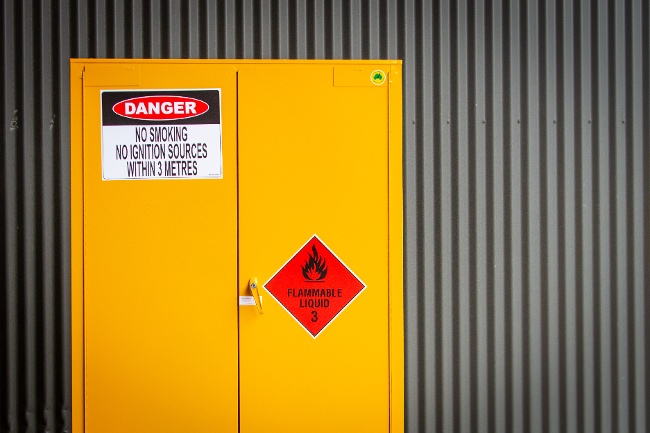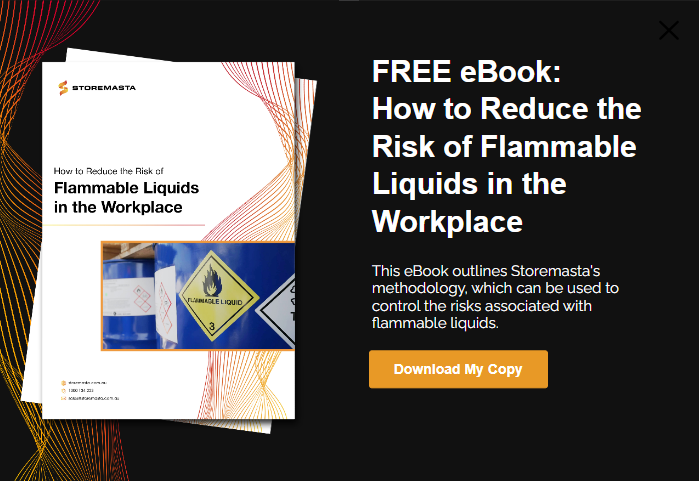When it comes to flammable liquids, every workplace has some quantity or type of Class 3 that they need to store. However, it’s sometimes confusing trying to determine the quantities that you can store in the workplace. In this post, we’ll break down some key considerations when you’re working out maximum capacities for your flammable liquids. We’ll discuss capacities and key requirements for minor storage, indoor package stores and outdoor storage.
Flammable Liquid Quantities – What You Need to Know
Due to the volatility of flammable liquids, it’s vital that businesses and organisations understand the requirements of safe storage. This means knowing how much of a product you can store – and where it should be stored in the workplace.
Considerations include:
- Minor storage quantities – does the quantity onsite meet these requirements?
- Indoor package stores – are you adhering to maximum capacities for storage cabinets, segregation rules with incompatible substances and separation from aggregate quantities?
- Outdoor flammable liquid storage – how much can you store outdoors and where do your stores need to be placed to reduce fire risk and ensure compliance?
Before you purchase equipment to store flammable liquids, consider the type of chemical that you carry as well as the requirements that pertain to storage quantities and store locations.
Flammable Liquids Minor Storage Requirements
Minor storage refers to the storage of dangerous goods in quantities below a specific amount. Minor storage of flammable liquids in the workplace is defined by the class, packaging group and the type of workplace in which it’s stored — as well as its location within that building.
Some examples of minor storage quantities for various operations include:
| Building Type | PG I or PG II | PGIII |
| Commercial Buildings | 10L per 50 m2 of floor space, but 5 L for any tenancy of less than 50 m2 area | 2L per 50 m2 of floor space, but 25 L for any tenancy less than 50 m2 in area |
| Laboratories | 50L per 50 m2 of floor space, or 50 L in a room of up to 50 m2 of floor space | 100L per 50 m2 of floor space |
| Educational | 5L per 50 m2 of floor space | 10L per 50 m2 of floor space |
| Factories, Workshops (Indoors) | 1L per 2m2 of floor space, no more than 250L per 500m2 area | 1L per 1m2 of floor space, no more than 500L per 500m2 area |
| Construction Sites | 2500L | 5000L |
NOTE: See the Australian Standard 1940 for full details on Minor Storage of flammable liquids and their relevant packing groups (PG).
Multiple Minor Storage Separation Distances
When there are multiple minor storage facilities, they must be separated by distances of at least:
- 20 m: indoors
- 15 m: outdoors
If your quantities exceed those of minor storage, more stringent requirements do apply.
Minor Storage in Flammable Cabinets
While there are a wide range of requirements to ensure safety during minor storage – such as spill containment, ventilation and isolation of ignition sources – we always recommend a Class 3 Flammable Cabinet for the storage of your flammable liquids.
Choosing a compliant Class 3 cabinet is the safest option for flammable liquids storage of any quantity. Cabinets are available from 15L models to large 850L cabinets.
IMPORTANT: If your flammable liquids are packing group 1, and stored in containers greater than 2.5L, then they should not be in minor storage UNLESS they’re essential for daily operations. If this is the case, they must only be handled by trained staff.
Indoor Package Stores for Flammable Liquids
There are many types of packages stores that are suitable for flammable liquids, but in this instance, we’ll be looking at flammable cabinets.
Many workplaces choose flammable cabinets for Class 3 storage as they are a built-for-purpose solution that can be delivered to your site, providing all the necessary controls for flammable liquids storage. This negates the need for custom made package stores, which can take more time and money, while offering very similar chemical control measures.
REMEMBER: If you aren’t storing flammable liquids in a flammable cabinet, your store then needs to be separated from onsite protected places and public places. Internal package stores (except for cabinets) need to be located on floors accessible from the street level or the site roadway in the flammable liquids package store.
Flammable cabinets must always be located in areas that:
- Don’t impede emergency evacuations
- Are free from ignition sources
- Provide segregation from incompatible substances
There are also limits to how much flammable liquid can be stored indoors. Consider the following:
Adhere to Maximum Capacity for Cabinets
Always load your flammable liquids cabinet to the maximum capacity only. If you exceed this capacity you may be placing your workplace at risk of fire, spills and other hazards, as well as fines for non-compliance. You can find the maximum capacity of your cabinet on the front of your cabinet. It should be marked clearly, so it’s easy to read.
Determine Aggregate Quantities
Location can dictate how much flammable liquid you can store indoors. The aggregate capacity of the flammable liquids storage cabinets should not be greater than:
- 850L per 250m2 on ground floors, or
- 250L per 250 m2 on other floors
Also, keep in mind that each aggregate quantity must be separated by a distance of at least 10 metres to ensure safety.
Consider aggregate quantities of flammabe liquids, as requirements apply to the quantity stored, as well as separation distances from other stores.
Operational Requirements
When storing your flammable liquid in a flammable cabinet, remember that there are some safety precautions you need to follow.
These include:
- Drums larger than 60L in capacity must only be stacked two high to avoid spill risk
- Only one drum larger than 60 L should be kept in a horizontal (decanting) position at any time
- Packages need to be closed or fitted with a tap
Cabinets Larger than 250L:
For flammable cabinets that are larger than 250L, there are many requirements as to where these can be installed. These larger flammable cabinets must only be installed on floors with direct access from the street or ground level.
They must NOT be installed in a range of properties including:
- Residential, accommodation or commercial buildings
- Hospitals
- Aged care buildings
- School buildings
If you can install a flammable cabinet larger than 250L in your workplace, it must not be located closer than 3 metres to any wall that is common with another room.
The only exception is if the wall is constructed of:
“concrete or masonry to ceiling height or 3 metres above the top of the cabinet (whichever is less) and 3 metres to either side of the cabinet.” – AS 1940, 4.9.6 Cabinet Location
Flammable Cabinet Controls
Flammable cabinets have a range of controls to make storage indoors a safe and compliant experience. These include sheet steel construction with thermic air barrier, to reduce heat radiation. Storemasta flammable cabinets are also fitted with our patented door closing system which provides automatic, sequential closing doors that help prevent vapour emissions and spills. Flammable cabinets also feature spill containment systems, with perforated shelving to allow air flow.
Storemasta flammable cabinets are available is models ranging from 15 litre to 850 litre options.

Flammable liquid storage requires a range of considerations including quantities and the location of cabinets or stores.
Ventilation Requirements for Flammable Liquids
Another important consideration to make is the air quality of your workplace. As you already know, flammable liquids emit a flammable vapour – which poses an ignition risk as well as a health hazard if it exceeds a certain level.
The workplace exposure standards list hundreds of hazardous chemicals. They contain the statutory maximum upper limit of exposure to airborne contaminants to ensure a safe work environment.
Ensure good air quality within your workplace, not only reduces the risk of fire and improves worker health and safety, but it’s an obligation that you must fulfil. You should regularly monitor your workplace for airborne contaminants and ensure that sufficient natural and/or mechanical ventilation is provided.
In addition to this, we highly recommend conducting onsite risk assessments, to ensure that your dangerous goods and hazardous chemicals are properly controlled and that compliance is sustained.
Some helpful tips to reduce airborne contaminants include:
- Only ordering the chemicals that you need and keeping a tight inventory on all flammable liquids and other hazardous substances
- Make sure all flammable liquids containers, drums, IBCs or other storage or dispensing equipment is free from residue
- Identify and clean up flammable liquid leaks and spills as soon as they occur
- Make sure staff are equipped with the proper PPE and only work in areas where there is ample ventilation
- If ventilation systems are required for flammable cabinets, make sure the system is compliant
REMEMBER: You can refer to the safety data sheet for each flammable liquids product to determine the workplace exposure levels for that chemical. This will help you identify any problems and keep your stores and workplace within legal limits.
Outdoor Storage of Flammable Liquids
For storage of more than 850L of flammable liquids per 250 m2 of floor space, you’ll need to consider flammable liquids storage outdoors – or have a custom-built fire rated package store constructed.
Due to the relative simplicity and affordability of outdoor flammable liquids storage, many workplaces choose a Class 3 chemical storage container or a dangerous goods container for the outdoor storage of flammable liquids.
When installing outdoor storage equipment, you should also consider:
- Separation distances from public and protected places
- Avoiding areas prone to floods or cyclones
- Incompatible substances stored in the same outdoor area
- Issues with heat or direct sunlight that might affect your chemicals
Quantities of flammable liquids stored outdoors should be subject to a risk assessment, however, as long as the store is located in compliant position with regard to the above considerations, you may store large volumes in the outdoor environment.
Outdoor Flammable Store Capacities
Flammable liquid stores come in a range of sizes from 250 litres to 10,000 litre flammable stores.
Chemical storage containers can store packages, drums or IBCs of flammable liquids, and are equipped with natural ventilation, secure locking bars, spill containment and dangerous goods and hazard signage.
These outdoor DG Containers are fully relocatable, with this model storing up to 8,000 litres of flammable liquids.
Emergency Decontamination Equipment
For the safety of those working with flammable liquids, outdoor flammable liquids storage containers larger than 2000L require a safety shower and eyewash facility (that complies with ANSIZ358.1). This is for emergency decontamination, if there is a leak, spill or accident at the site. The compliant facilities must be installed near the storage equipment, so staff can easily access the safety shower and eyewash if required.
How Much Flammable Liquid Can You Store?
To learn more about ensuring flammable liquids safely, read our helpful guide. This outlines the considerations required when storing flammable liquids to ensure optimum safety. It also offers an outline of risk management best practice, so you can create the safest possible environment when working with Class 3 liquids.

Living life by the 4 C’s of marketing – communication, coffee, compliance… and more coffee – Leisa Andersen is Storemasta’s Content Marketing Manager. When she’s not writing, you’ll find her enjoying all the good things in life, including shopping, travel and gluten free donuts.




-1.jpg?width=600&height=400&name=New%20Container%20(6%20of%208)-1.jpg)
